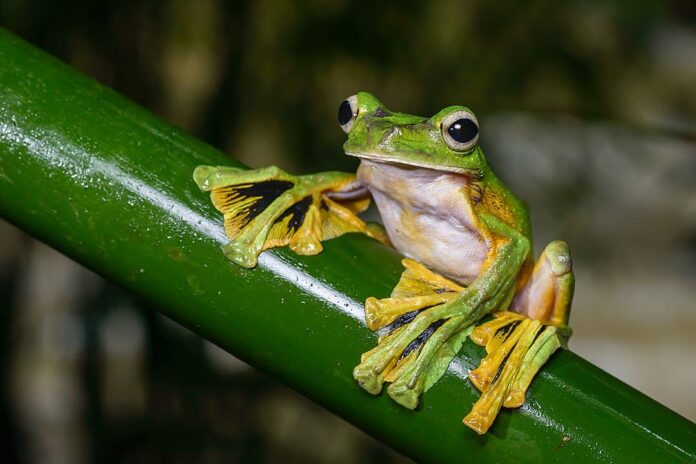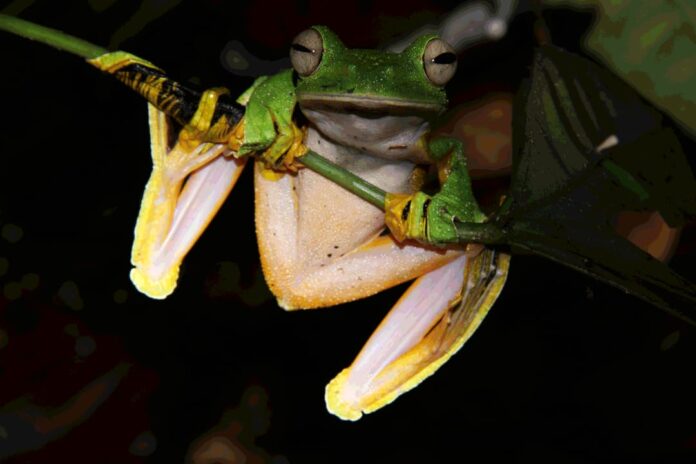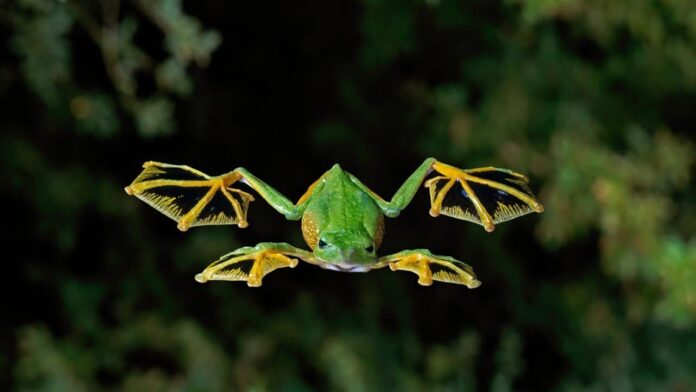Wallace’s flying frog aka the gliding frog has very unique limbs that allow it to parachute across the forest. This amphibian does not only have an interesting appearance but also lifestyle, and coming across one is super cool. Looking absolutely out of this world, there are many cool things about Wallace’s flying frogs for you to know. Feel free to check out some information below and let me know your thoughts.
1Appearance

Growing to a size of 8 to 10 centimeters, they are one of the largest flying frogs in the world. A Wallace’s flying frog has a bright and shiny green back with a white to pale yellow underside. It has very long limbs, and the bright yellow fingers and toes are webbed right to the tips. The skin between those limbs is stretchy, giving the impression of even larger feet. These special webbed toes allow the frogs to parachute and glide from the trees down to the forest floor effortlessly. What else is big in this frog? Its pale yellow eyes, of course, the bulging eyes with horizontal pupils that appear as if it is judging you.
2Behavior
Wallace’s flying frogs live almost exclusively in trees, and they only descend to mate and lay eggs. However, they also fly and leap from tree to tree or to bushes for food on some occasions as well. With a lightweight body and strong limbs, flying is nothing difficult for these parachute frogs. The glide can be as far as 15 meters or more, usually from branch to branch or all the way to the ground. What about the landing impact? None, because they have oversized toe pads that provide a soft landing and stick to tree trunks.
Another fascinating yet strange behavior that these frogs have is breeding. During the rainy season from November to March, Wallace’s flying frogs begin to gather and congregate on the ground to mate. Females will excrete a liquid which they turn into foam by beating it quickly with their hind legs. Then they will lay their eggs in their foamy nest, and the males will fertilize the eggs while the eggs are being laid. Their nest site is usually near a water source, at a tree branch above the wallow. When the eggs hatch, the nest will collapse and send the larvae into the wallow below.
3Feeding & Habitats

This large frog feeds mainly on insects; however, hunting small birds and toads is also common. The Wallace’s flying frog’s range is from the Malay Peninsula to Western Indonesia as well as Brunei, Myanmar, and Thailand. They inhabit moist tropical forests, primary forests, and rainforests, living in bushes, palm trees, and other trees that are far off the ground. These arboreal frogs usually occupy the mid-canopy level and you won’t find them in areas that lack tree or bush cover.
4Predators & Threats
Their common predators are tree-climbing snakes such as cat snakes and tree snakes. Despite being in the Least Concern class on the IUCN Red List, they do face some threats in their natural homes. The major threats include deforestation, habitat degradation, and habitat fragmentation which decrease their range every year. Along with that, though small, pet trade is also another concerning threat to the Wallace’s flying frogs.
Related Post: Flying Harlequin Tree Frogs




